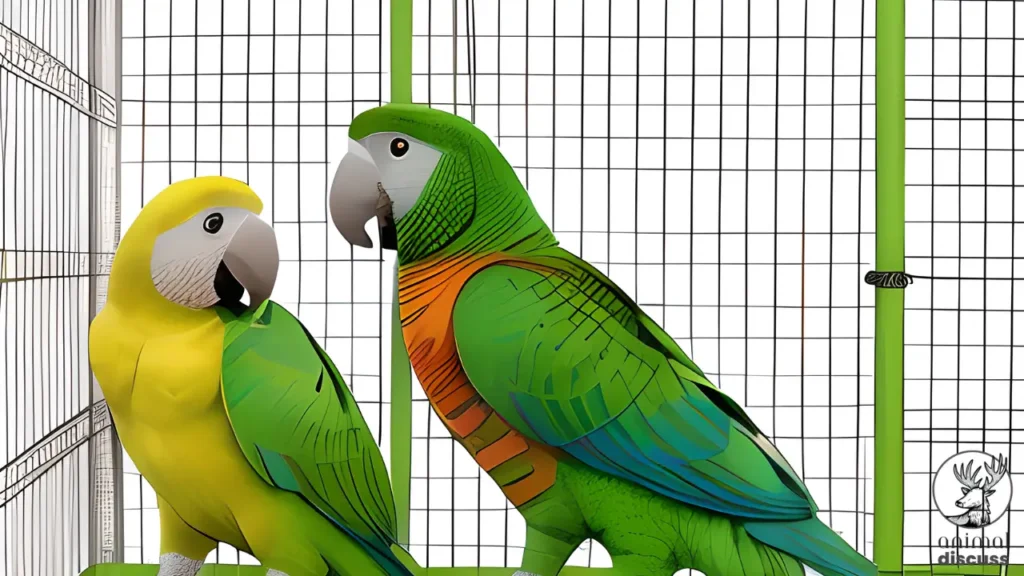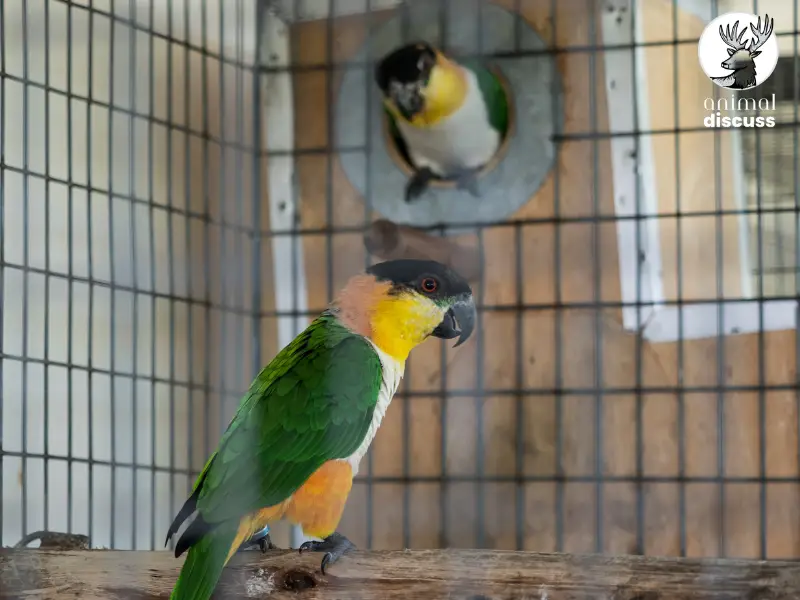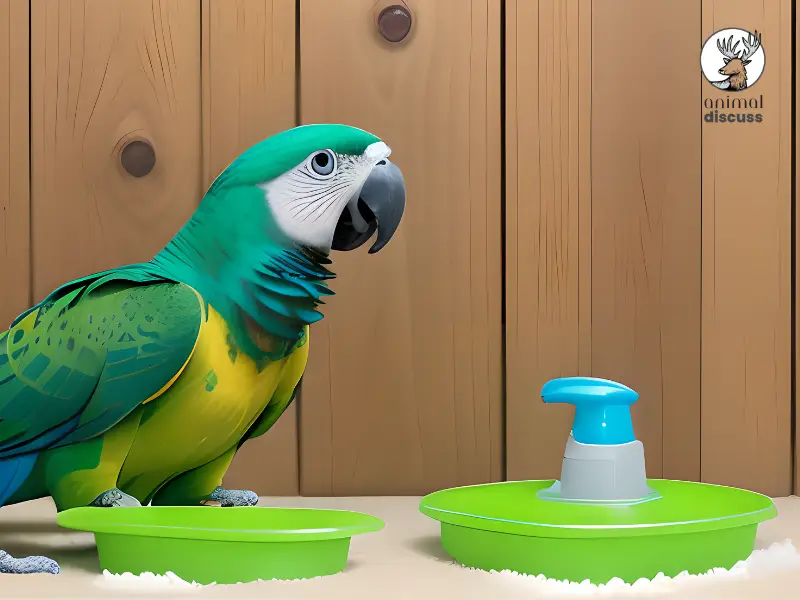This is the complete guide to building an ideal parrot habitat that ensures both happiness and health for your feathered friend.

Every detail matters when creating a space that mimics their natural environment.
In this guide, you’ll learn:
- How to select the perfect cage size and material
- The role of sunlight and UV light in parrot health
- Essential cleaning routines for a hygienic habitat
- Tips for climate control and weather-proofing
- Ways to enrich your parrot’s mental well-being
Whether you’re setting up a habitat for a budgie or a macaw, this guide breaks down everything you need to know. Let’s craft the perfect home your parrot will adore!
1. What is an Ideal Habitat for a Parrot?
Creating an ideal habitat for a parrot ensures their physical and emotional well-being. Parrots are intelligent, active birds with unique environmental needs. Mimicking their natural surroundings enhances their health and happiness.
What Defines a Suitable Environment for Parrots?
Parrots thrive in environments resembling their natural habitats. These birds, often found in tropical rainforests, appreciate settings rich in greenery, ample space, and climbing opportunities.
A parrot’s habitat should promote freedom of movement and interactive activities.
What Are the Natural Habitat Preferences of Parrots in the Wild?
In the wild, parrots inhabit diverse regions, from dense forests to savannas.
They build nests in tree hollows and prefer areas with access to food, water, and safety from predators. Understanding their wild preferences is key to replicating these conditions in captivity.
How Can These Preferences Be Replicated in Captivity?
To replicate their natural habitat, ensure the enclosure is spacious, enriched with toys, and equipped with natural elements like wooden perches and climbing branches.
Including natural sounds or soft music can also make the environment feel more familiar. [Parrot Society UK, American Federation of Aviculture (AFA)]
2. Why is a Proper Habitat Crucial for a Parrot’s Health?
A proper habitat directly impacts a parrot’s mental stimulation, emotional stability, and overall health.
Parrots are sensitive creatures prone to stress if their surroundings are inadequate.
How Does Habitat Influence a Parrot’s Mental and Physical Health?
A well-designed habitat keeps parrots active and prevents boredom.
Mental stimulation, achieved through interactive toys and varied perches, avoids issues like feather plucking or aggression.
Physically, adequate space ensures muscle development from regular movement.
What Happens When a Parrot’s Habitat is Poorly Designed?
A cramped or unsafe habitat leads to stress and health complications.
Parrots may develop obesity from inactivity or respiratory problems from poor air circulation. Behavioral issues often stem from inadequate stimulation.
How Does a Well-Designed Habitat Prevent Behavioral Issues?
Providing an engaging and spacious habitat reduces destructive habits. Features like rotating toys and climbing structures encourage curiosity and healthy behaviors.
3. What are the Essential Elements of a Parrot Habitat?
Every parrot habitat requires certain fundamental components to ensure the bird’s well-being and comfort. From cage dimensions to accessories, every detail matters.

Cage Size and Materials: What Should You Prioritize?
Choose a cage large enough for your parrot to stretch its wings fully.
For small parrots like budgies, a minimum size of 18″x18″x24″ is ideal, while larger species like macaws need at least 36″x48″x60″.
Always opt for stainless steel or powder-coated cages to avoid toxic materials.
Perches, Swings, and Other Accessories: What is Essential for Comfort?
Perches of varying diameters made from natural wood promote healthy feet. Swings and ladders provide exercise opportunities, while chewable toys cater to their gnawing instincts.
Is Natural Lighting or UV Light Necessary for Parrots?
Parrots need exposure to natural sunlight or full-spectrum UV lights to synthesize Vitamin D and maintain strong bones. Position the cage near a window but avoid direct, harsh sunlight.
4. How to Design a Safe and Engaging Parrot Habitat?
Designing a parrot habitat involves balancing safety with stimulation. A safe and enriching environment ensures a happy, active bird.
What Safety Hazards Should Be Avoided in a Parrot’s Cage? Avoid using toxic plants, sharp-edged materials, or small spaces where the parrot can get stuck. Ensure that bar spacing matches the parrot’s size to prevent escape or injury.

How to Create Mental Stimulation with Toys and Activities? Rotating toys weekly keeps your parrot intrigued. Puzzle feeders challenge their intelligence and mimic natural foraging behaviors, providing both fun and stimulation.
Should Parrots Have a Dedicated Out-of-Cage Space? Yes, parrots benefit from spending supervised time outside their cages. A dedicated play gym or stand offers additional exercise and prevents boredom.
5. What Role Does Diet and Hydration Play in a Parrot Habitat?
Diet and hydration are central to a parrot’s overall well-being and should be integrated seamlessly into their habitat design.
How Should Food and Water Be Placed in the Cage? Place food and water dishes in easily accessible yet secure spots. Hanging feeders minimize spills, while separate bowls for seeds, fruits, and water ensure hygiene.
What Types of Feeders Suit Parrots Best? Stainless steel feeders are durable and non-toxic. Avoid plastic feeders as they may harbor bacteria or be chewed through by curious parrots.
How to Ensure Cleanliness in Feeding Areas? Regularly wash food and water bowls to prevent contamination. A clean feeding environment avoids issues like bacterial infections.
6. How to Maintain and Clean a Parrot Habitat?
Cleanliness is vital to maintaining a healthy parrot habitat. Dirty cages can lead to disease and discomfort.
What is the Ideal Cleaning Schedule for a Parrot’s Habitat? Daily cleaning of droppings, uneaten food, and soiled bedding is essential. A deep cleaning involving scrubbing and disinfecting should be done weekly.

How to Safely Disinfect Without Harming the Parrot? Use bird-safe disinfectants or a vinegar-water solution. Rinse thoroughly and allow the cage to dry completely before returning your parrot to its habitat.
Why is Regular Maintenance Critical for a Parrot’s Well-Being? Routine cleaning reduces the risk of respiratory infections and pest infestations. Regular inspections for wear and tear ensure the habitat remains secure.
7. What Common Mistakes Should Be Avoided in a Parrot Habitat?
Many parrot owners unknowingly make habitat design errors that can harm their birds.
Why is Overcrowding a Common Issue in Parrot Cages? Overcrowding limits movement and increases stress. Parrots need space to exercise and avoid territorial disputes.
How Does Improper Perch Placement Affect Parrots? Poorly placed perches can lead to foot strain or difficulty accessing food. Place perches at varying heights to promote natural climbing behavior.
What Are the Dangers of Using Unsuitable Materials? Materials like zinc-coated metals or certain plastics can be toxic. Stick to bird-safe, non-toxic materials only.
8. Can a Parrot Habitat Be Customized for Different Parrot Species?
Different parrot species have unique habitat requirements based on their size, activity levels, and natural habits.
How Do Habitat Requirements Differ for Macaws, Cockatiels, and Budgerigars? Macaws need larger cages with sturdier materials, while budgies thrive in compact but enriched spaces. Cockatiels benefit from open-top cages for occasional flight.

Are There Specific Plants or Decorations Suitable for Each Species? Bird-safe plants like spider plants or herbs like basil provide natural enrichment. Decorations should align with the bird’s size to avoid swallowing risks.
How to Address Size and Activity Level Differences in Habitat Design? Larger parrots like African greys need more climbing structures, while smaller birds require finer details like smaller swings or thinner perches.
9. How to Transition a Parrot to a New Habitat?
Transitioning a parrot to a new habitat requires patience and gradual adjustments.
What Steps Ensure a Smooth Transition for the Parrot? Introduce the new habitat slowly by placing familiar toys or perches inside. Let the parrot explore at its own pace to reduce anxiety.
How to Make the Habitat Feel Familiar and Comfortable? Using existing accessories helps maintain familiarity. Avoid introducing new elements all at once.
What Signs Indicate the Parrot is Adapting Well? A parrot that eats, plays, and vocalizes in its new habitat is adjusting successfully. Signs of stress, like feather plucking, indicate further adjustments are needed.
10. How Does Climate Impact Parrot Habitat Design?
Parrots are sensitive to climate and require specific conditions to thrive.
What Temperature and Humidity Levels Are Ideal for Parrots? Maintain temperatures between 65-85°F with humidity levels around 40-60%. Extremes can cause stress or health issues.
How to Adjust the Habitat for Different Seasons or Regions? In colder regions, use heating elements like bird-safe warming panels. In hot climates, provide adequate ventilation and shaded areas.
What Are the Signs of Climate-Related Stress in Parrots? Panting, shivering, or lethargy indicate temperature discomfort. Address these signs immediately to ensure the bird’s well-being.
Final Words
Creating the perfect habitat for your parrot is more than a responsibility—it’s an opportunity to provide a thriving and joyful environment. From choosing the right cage size to ensuring a balanced diet, every detail plays a pivotal role in their well-being.
Maintaining cleanliness, regulating climate, and offering mental stimulation are equally vital. These steps not only improve your parrot’s health but also strengthen your bond with them.
By following these expert-backed strategies, you’re setting up your parrot for a life of comfort and happiness.
References
- Parrot Society UK
- BirdChannel.com
- Veterinary Centers of America (VCA)
- LafeberVet

